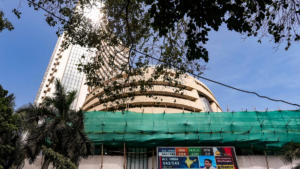The Indian stock market saw a bear attack on Monday, with BSE Sensex crashing 865 points or 1.01 per cent to 84,706 levels, while Nifty falling 252 points or 0.96 per cent at 25,926 levels in intraday deals.
The retreat comes on the back of consecutive fresh highs breached by the benchmarks Sensex and Nifty in the last couple of weeks. Earlier on Friday, too, the bourses hit new highs with Sensex touching 85,978.25 and nearing the 86,000 mark, while the Nifty reached a fresh peak of 26,277.35 level.
Click here to connect with us on WhatsApp
The index heavyweights that pulled the BSE Sensex down on Monday in terms of contribution included Reliance Industries, ICICI BANK, HDFC Bank, Axis Bank and Bharti Airtel falling up to 2 per cent each among others. RIL’s share price fell the most, plummeting 2.11 per cent at Rs 2,988 per share in the intraday trade on the BSE.
Among sectoral trends, all but three sectors were in red, with the Nifty Realty slipping the lowest, sliding up to 1.90 per cent intraday. Realty stocks such as Phoenix Ltd, Prestige, Godrej Properties, Lodha and Sobha fell in the range of 1-5 per cent each.
Other sectors such as Nifty PSU Bank, Private bank, Financial Services and Oil and Gas among others also dipped over 1 per cent each intraday. On the other hand, metal and consumer durable stocks kept shining, despite overall market weakness.
The Nifty Metal index was up 1.66 per cent, while Nifty Consumer Durables and Nifty FMCG were up slightly by 0.10 per cent and 0.02 per cent, respectively.
The broader markets too showed weakness, with the BSE SmallCap index falling 0.75 per cent after hitting its all time high at 56,662.46 level intraday. The BSE MidCap index on the other hand slumped by 0.81 per cent at 49,086.78 intraday
According to analysts markets are moving into a consolidation phase with foreign investors eyeing Chinese stocks over Indian shares.
“Market is likely to move into a consolidation phase in the near-term. One significant factor that is influencing foreign portfolios is the outperformance of the Chinese stocks which is reflected in the massive surge in the Hang Seng index by around 18 per cent in September. This surge has been triggered by hopes of revival in the Chinese economy in response to the monetary and fiscal stimulus announced by the Chinese authorities. The cheap valuations of Chinese stocks are keeping the momentum intact,” said Dr V K Vijayakumar, Chief Investment Strategist, Geojit Financial Services.
According to Dr Vijayakumar, this means that FIIs may continue to sell in India and move some more money to better performing markets. However, he added that FII selling is unlikely to impact the Indian market significantly since the massive domestic money can easily absorb whatever the FIIs are selling. “Investors can use dips to buy quality large caps which are fairly valued,” he said.
Technical View
Technically the Nifty Index has formed its first red candle on the daily charts, indicating a shift in momentum due to emerging bearishness and profit booking, analysts noted.
“Following a strong rally, overbought conditions in several technical indicators suggest a potential short-term pullback. Key support levels are at 25,920, 25,700, and 25,350, which may present favourable buying opportunities after a correction. The recommended strategy is to book profits at the current market price and await a pullback before re-entering long positions near these support levels,” said Ravi Nathani, independent technical analyst.
Global markets
The pullback in Indian equities also comes amid a slowness in some Asian peers, with Japan’s Nikkie falling 4.86 per cent, and broad based Topix 3.50 per cent. This came after the country’s industrial production fell by 4.9 per cent year-on-year in August, a significant drop compared to the 0.4 per cent decline recorded in the previous month.
South Korea’s Kospi also slumped by 1.31 per cent, while Australia’s ASX/200 was up 0.56 per cent.
Mainland China’s CSI 300 also rose 6.22 per cent, with the property sector gaining 7.4 per cent. In Hong Kong, the Hang Seng index increased by 3.34 per cent, driven by consumer stocks, while the Hang Seng Mainland Properties Index surged 8 per cent. The Chinese and Hong Kong market jumped after China’s official purchasing managers’ index for September came in at 49.8, slightly above the expected 49.5. However, The Caixin PMI, however, fell to 49.3 from 50.4, missing the expected 50.5.
First Published: Sep 30 2024 | 11:19 AM IST


